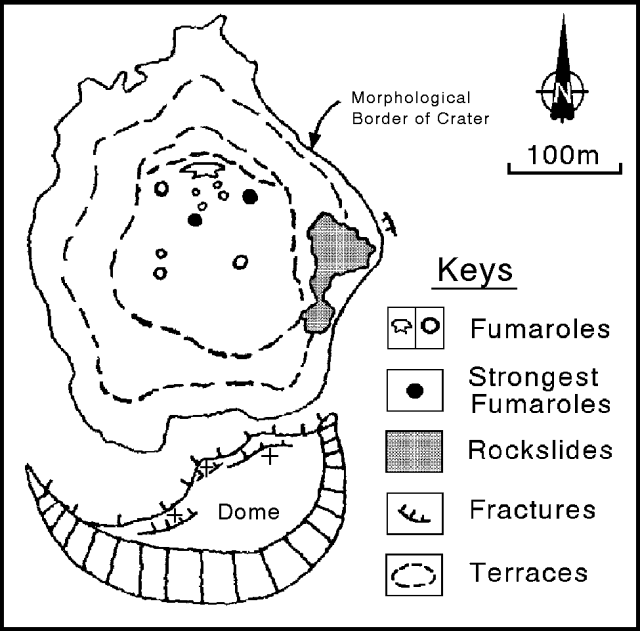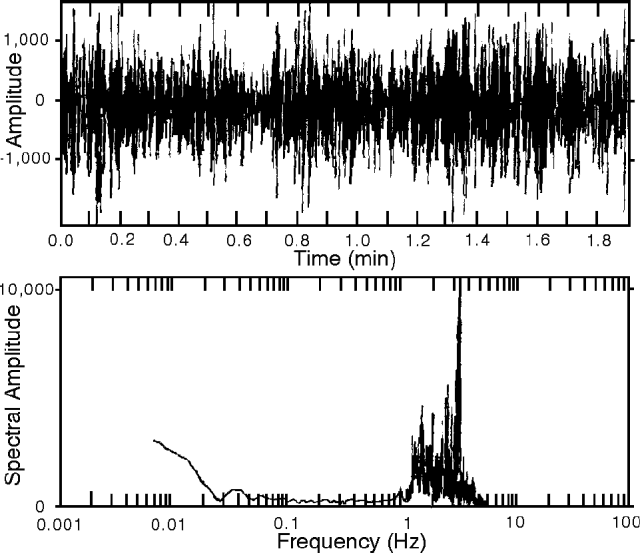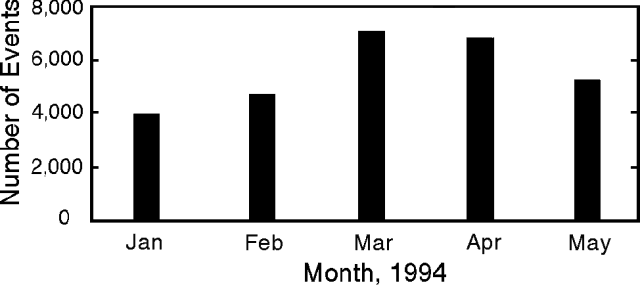Report on Poas (Costa Rica) — May 1994
Bulletin of the Global Volcanism Network, vol. 19, no. 5 (May 1994)
Managing Editor: Richard Wunderman.
Poas (Costa Rica) Northern crater lake nearly dry; gases cause environmental damage
Please cite this report as:
Global Volcanism Program, 1994. Report on Poas (Costa Rica) (Wunderman, R., ed.). Bulletin of the Global Volcanism Network, 19:5. Smithsonian Institution. https://doi.org/10.5479/si.GVP.BGVN199405-345040
Poas
Costa Rica
10.2°N, 84.233°W; summit elev. 2697 m
All times are local (unless otherwise noted)
In May, gases from the shrunken and nearly dry lake, Laguna Caliente, continued to present an environmental problem. Dry weather and persistent eruptive activity led to a decrease in the level of both the lake and surrounding groundwater. The retreat of the lake had reached the point that it appeared nearly dry in March, but fumarolic degassing persisted from a number of locations on the crater floor (figure 48). In the absence of abundant water, volcanic gases vented more directly into the atmosphere, causing fumaroles to degas more vigorously and sometimes even to resemble low-energy explosions.
 |
Figure 48. The active crater at Poás in late May 1994. Original sketch provided by G.J. Soto of ICE. |
Volcanic gas concentrations have risen in the area adjacent to the National Park (SE, S, SW, and W of the main crater); residents in its vicinity have reported a "strong sulfur smell." These odors forced the Park to close on 26-27 May and at least once in June. They were particularly strong at dawn, and some emissions had yellow and bluish colors. Acidic rainfall also increased such that economic losses since 1988 were on the order of several million dollars (US). Areas of loss encompassed timber, crops, machinery, grazing land, livestock, habitations, and human health. Health complaints have included nausea and coughing, and irritated throat, eyes, and skin.
In contrast, the fumaroles located on the S part of the crater toward the dome appeared comparatively unchanged. They had stable temperatures (89°C) and continued to emit steam-rich components.
ICE reported that microseismicity at Poás has mainly consisted of low-frequency events located beneath the crater lake. From last January through May 1994 the microseismicity has doubled.
OVSICORI reported that during May, station POA2 (located 2.5 km SW of the active crater) registered a total of 5,228 low-frequency events (figure 49). POA2 registered medium-frequency events (99), and high-frequency events (9). POA2 also registered continuous low-frequency tremor with peak-to-peak amplitude slightly under 3 mm, at times reaching 5 mm. The tremor signal was strong in the frequency range 2.0-3.2 Hz (figure 50). The highest seismicity took place on 25 and 31 May, the lowest, 15 May, a day that still received continuous tremor.
 |
Figure 50. Poás tremor beginning at 1343 GMT, 16 May 1994 (top) and spectral analysis of the tremor (bottom). Amplitudes are arbitrary. Courtesy of OVSICORI. |
Compared with the month of April, low-frequency seismicity decreased 13%, medium-frequency increased 76%, and the high-frequency remained about the same. In May, the number of hours of tremor increased—coincident with the above mentioned rise in the vigor of fumarolic activity. On 18 May a M 2.5 earthquake took place at a depth of 15 km centered 3.3 km NE of the active crater. During April and May there was no significant deviation in deformation.
Geological Summary. The broad vegetated edifice of Poás, one of the most active volcanoes of Costa Rica, contains three craters along a N-S line. The frequently visited multi-hued summit crater lakes of the basaltic-to-dacitic volcano are easily accessible by vehicle from the nearby capital city of San José. A N-S-trending fissure cutting the complex stratovolcano extends to the lower N flank, where it has produced the Congo stratovolcano and several lake-filled maars. The southernmost of the two summit crater lakes, Botos, last erupted about 7,500 years ago. The more prominent geothermally heated northern lake, Laguna Caliente, is one of the world's most acidic natural lakes, with a pH of near zero. It has been the site of frequent phreatic and phreatomagmatic eruptions since an eruption was reported in 1828. Eruptions often include geyser-like ejections of crater-lake water.
Information Contacts: G. Soto, G. Alvarado, and F. Arias, ICE; H. Flores, UCR; E. Fernández, J. Barquero, V. Barboza, and W. Jiménez, OVSICORI.


